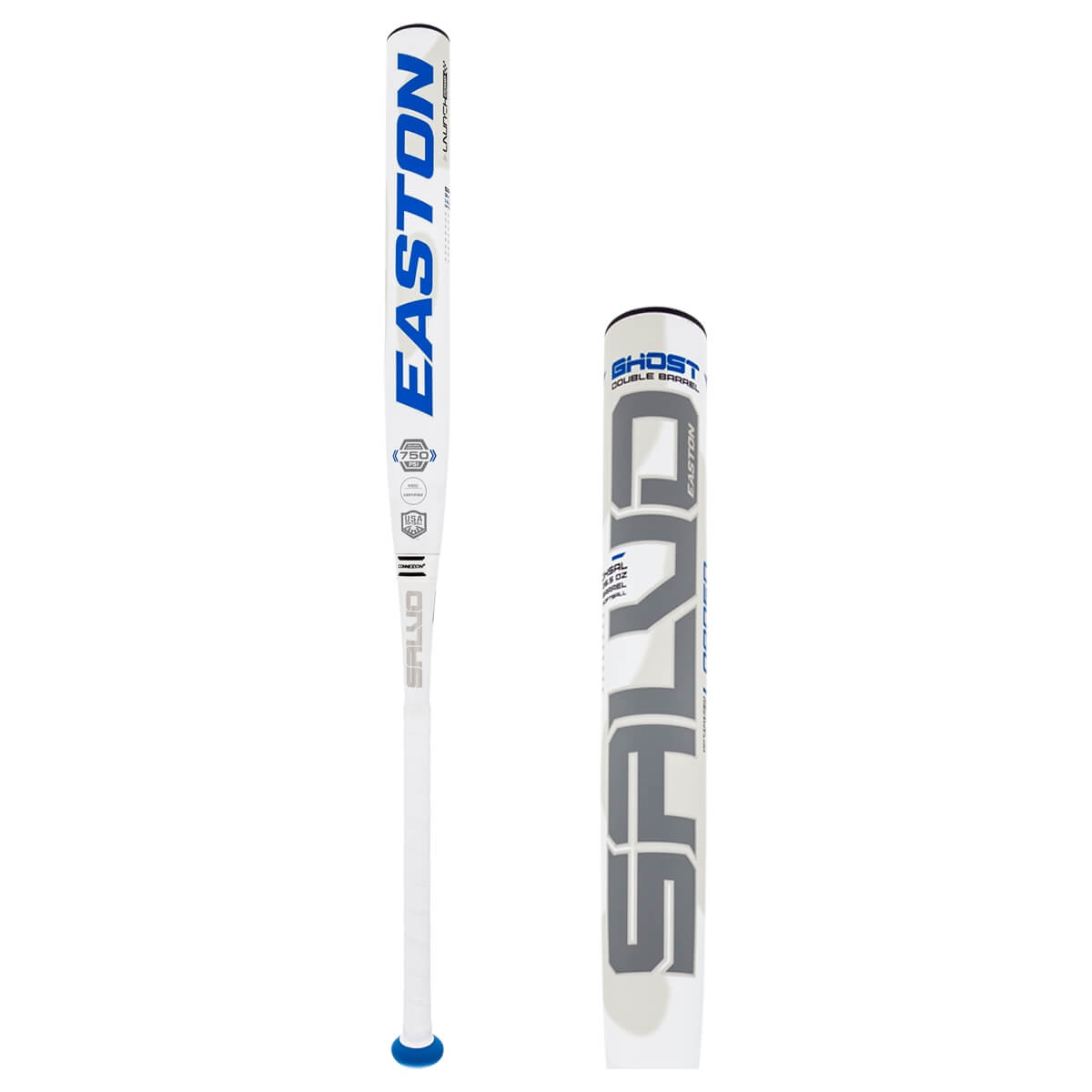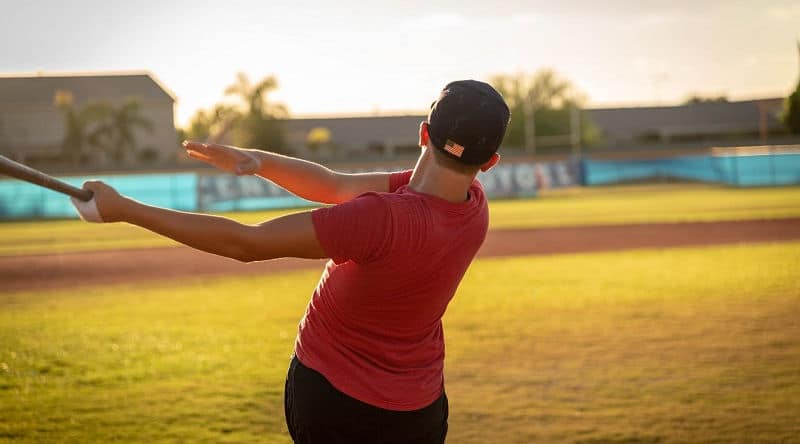Slow pitch softball is one of the best ways to spend a weekend with family and friends. But it’s all fun and games until you step up to the plate. The best slow pitch softball bat needs to give you an edge over your adversaries & help you swing for the fences with ease. Below, we review your best options for 2022 & 2023.
Our pick for best USSSA slow pitch bat, and best ASA slow pitch bat of 2023 is the Miken Psycho 13″ SuperMax Dual Stamp which offers fantastic performance at a great price. Even better is that the Psycho is dual stamped (USSSA and USA) bat, making it legal in just about any league that allows the use of composite bats. What’s not to love?
Best USSSA-240 Bats of 2023

The Psycho always has always been one of our favorite picks thanks to its excellent price point, and performance. For 2023, this is our overall best pick for best USSSA slow pitch bat and best USA slow pitch bat.
The 2023 Psycho is a one-piece fully composite, dual stamped (USSSA and USA Softball) bat, with a 13 Inch long-barrel, and Miken’s 1 Oz SuperMax end load. We love its performance right out of the wrapper – it has loads of pop on hits, and a beefy end load that pairs well with a 13-inch long barrel to put power behind the ball.
Verdict: Great pop, nice weight, and power. However, the grip feels a cheap and tacky, but this is easy to fix with a Vulcan or grip to a Lizard Skin grip especially since its one piece construction will ring you up on mishits.

Miken/Worth bats have always been solid performers in the USSSA slowpitch space. In particular, the Krecher has been a best slow pitch softball bat pick year after year. This year’s model is a two-piece, fully composite bat with a slightly end loaded swing weight thanks to a 1/2 ounce XL load, and a 13.5″ long barrel.
This bat sports a huge sweet spot and a big forgiving barrel that still crushes balls whether off the hands or towards the end of the barrel.
Performance-wise, the Krecher starts out super hot right out of the wrapper, registering high 90s on velo test, and breaking the 100 mark after several dozen swings. The barrel showed did show signs of webbing a few swings in, so we recommend keeping this as your gamer, and perhaps picking up the cheaper Psycho as your BP bat.
One to check out if you’re a contact hitter who prefers a long barrel, 1/2 ounce end load on your bat. However, if you hit for power and prefer something heavier, check out the 12.5″ 1 oz end load Shannon Smith Krecher.

The Vanilla Gorilla comes as a two-piece (composite barrel and alloy handle) 24 to 28 ounce, with a 12-inch barrel that makes it surprisingly easy to find the sweet spot. It has an end loaded that feels like a 0.75 to a full 1 oz end load. Barrel feels great, good feedback, and the end load was present, but didn’t feel overwhelming. The alloy handle is stiff, which causes the barrel to deflect more for enhanced performance. We put some cuts on it and it starts out incredibly hot out of the wrapper and only got hotter. Durability seems great – no webbing or cracking even after fully working it in. Performance was good and consistent performance across the barrel’s length even on mishits.

The 2023 Avenge Pro Flared USSSA is a two-piece, all-composite bat with a full 1-oz end load. You’ve probably had good things about this bat – we have too, and it lived up to the hype. Unfortunately, the flared model is currently only available in USSSA.
This bat carries the usual mods, i.e carbon barrel construction, a vibration damping collar, and a modified end cap which makes for a bigger barrel, and larger sweet spot. However, its most noticeable feature is the new flared knob taper design – the Axe handle has always been its most polarizing feature. The smaller flared handle on this bat is barely noticeable, and feels a lot more natural and comfortable.
Our verdict: this thing is gas. Great feel, huge sweet spot, and no break-in period – triple digits right out of the wrapper. We were doing 100+ mph exit velo tests a handful of swings in.
Best ASA/USA Bats of 2023

The 2022 Krecher is a two-piece, all composite bat with a 13.5 long barrel and carries a 0.5oz endload. Construction feels solid, and initial swings showed no webbing, cracking or seaming whatsoever.
This bat feels incredibly solid right out of the wrapper with great pop, and a huge, forgiving sweet spot. Performance gets better the more we swung, even when the bat had some ways to go to full break-in. Break in period is quick and doesn’t need too many swings – this bat really comes alive at the 100 swing mark. We love that it sounds great – every time you hit it sounds like you smash the ball, that it doesn’t sting if you get jammed up, and its simple understated design.
The only downside is its bat grip, which is flimsy at best and came undone after several sessions. Rewrapping it in some bat grip tape should do the trick.

This two-piece all-composite slow pitch bat is USA Softball (ASA) certified, and is easily one of the best ASA/USA slow pitch bats we’ve swung. Fun fact, the Mach 1 USA bat fittingly pays homage to the Ford Mustang Mach 1 428 Cobra Jet. The 428 range of engines were nicknamed “Cobra Jet”.
The Mach 1’s 13.5-inch barrel has a slightly top heavy feel to it courtesy of a 0.5oz end load. This end load will suit power hitters that like a little bit of heft on their bats. The barrel offers a huge sweet spot, and the end load will give you more pop and responsiveness than most other ASA/USA bats we’ve swung. The Mach 1 lets you get some serious power behind the ball.
The joint on the Mach 1 allows for some handle-to-barrel flex, but not too much, meaning you maintain enough control to generate power and distance.
This bat whips through the zone super easy, has a huge sweet spot, lots of pop, and a super responsive barrel. Just remember to break it in to get it as hot as possible.

If you’re in the market for a balanced USA/ASA slow pitch bat, then this two-piece, all-composite slow pitch bat might just be what you’re looking for.
Tech-wise, there’s lots going on under the hood. First, the barrel tech features an inner tube and outer tube that work in harmony to form a bigger sweet spot, a fantastic barrel and durability. This durability is further enhanced via a barrel that is engineered to eliminate wall seams, so that your composite barrel doesn’t break after a few swings. The connection piece where the barrel and handle meet transfers energy to the barrel, flexes to increase whip through the zone, and limits unwanted vibration.
The Miken Freak Primo is an impressive bat with a huge sweet spot. Quite hot out of the wrapper as well but needs several hundred hits to be fully broken in. Contact hitters will love it for just how much the ball jumps off the bat, but it lacks the heft needed to hit the ball far. For this reason, we recommend the Primo is best suited for contact hitters.

[justbats link=”https://bit.ly/3eXKxNN”]
The USA/ASA Easton Ghost Salvo will definitely be a player favorite this season. This two piece all-composite design has become incredibly popular, as witnessed by the fact that the slow pitch space is replete with similar great options.
The Easton Ghost Salvo is a 13.5” barrelled slow pitch bat with a slight end load. We love this bat’s barrel profile, and the innovative tech used in an effort to push the limits of performance. For instance, its double barrel design uses a stronger outer barrel and lighter inner barrel which feels great in the hands. The Salvo has Easton’s distinct sound off hits, and most importantly, lots of pop.
The end load is slight (swings more like a balanced bat owing to barrel length), and will be better suited for contact hitters. This connection piece flexes enough for some players to like, but players who prefer a stiffer bat are better off swinging something like the Krecher or the Nautalai.
What Do You Need to Consider When Choosing the Best Slow Pitch Softball Bat?

Slow pitch softball bats feature in competitive or recreational leagues. They share certain things in common, which is a good starting point when looking for the best slow pitch softball bat.
Most of the slow pitch bats you’ll find today are 34″ long, have a 2 ¼ inch barrel, and weigh anywhere between 24 and 30 ounces. Construction-wise, slow pitch softball bats can either be fully aluminum, fully composite, feature a half-half construction with an alloy barrel and a composite handle, or be all-wood.
Certain associations govern slow pitch bats; namely, ASA, USSSA, ISA, NSA, Senior Softball (SSUSA), and bats thus need to adhere to these leagues’ regulations.
Let’s cover some of these things in detail below:
Slow Pitch Softball Bat Associations and Certifications
This, for obvious reasons, should be one of the most important considerations to make. Different leagues only use certain bats, so its important that the bat you buy meets your league’s regulations. The various sanctioned leagues are: USSSA, ASA, NSA, ISA, SSUSA, and ISF.
The most popular certifications you should look out for are ASA and USSSA. Here’s a little more about these league’s bat regulations.
USSSA Bat Regulation
USSSA bat regulations have changed a couple of times now (about 3 or 4), with the most recent change being around September 1st, 2020. This most recent change requires manufacturers to switch from 220lb compression to 240 lb compression, NTS tested bats, and stop making the old 220 lb compression bats. Therefore, as of 2021, manufacturers & players can only use the new NTS stamp on bats, and only 240 lb bats can sport this new USSSA Stamp on them.
The old 220 thumbprint bats were manufactured from 2012 to 2020. Bats with the 1.20 stamp, aka the “thumbprint” stamp, are legal for USSSA play indefinitely to give players more use out of their currently owned 1.20 bats. No new 220 bats can be approved for USSSA, and no new bats can have the old stamp after January 2021.
The new stamp USSSA bats start at a higher compression at 240 lbs. They have less pop than the old 220 bats, so players are better off swinging the old 220 models.
Because 240 lb bats are still fit for play in other associations such as NSA and ISA, manufacturers may decide to make 240 lb bats moving forward. Only time will tell.
NSA
Currently, NSA Slow Pitch Softball bats haven’t adopted the 240 lb, choosing instead to stick with the 2012-stamp 1.20 BPF standard or 220 lb compression for now.
Weight
Every player has different needs and preferences. Just because a teammate uses a 27oz bat, doesn’t mean you should too.
A bat that’s too light won’t give you adequate pop. Similarly, if you pick a bat that’s too heavy, you risk sacrificing swing speed & control through the hitting zone.
The best way to find your ideal bat weight is to try out a few different bats and see what works best.
Most slow pitch bats weigh between 26 and 30 ounces. 26 or 27 oz slow pitch bats are ideal for women. If you need an even lighter bat, however, the DeMarini Mercy slow pitch softball bat, for instance, is super lightweight, weighing in at 25 oz.
27 or 28 oz bats are relatively standard for men. However, elite players may use bats that weigh as much as 30 oz.
Balanced Vs. End loaded
Once you’ve picked out your ideal bat weight, the next thing to consider is how this weight is distributed along the bat’s length. Bats can either be balanced or end-loaded. What’s the difference between an end loaded vs balanced bat?
Balanced Bats
This kind of bat is a lot more common and has the weight spread out evenly across the bat’s length. What this sort of weight distribution does is keep swing weight low. This gives players a smoother swing, faster swing speeds, and greater bat control. Balanced bats are preferred by players who want to generate bat speed players aka contact hitters aka base hitters.
End-Loaded Bats
End loaded bats are better suited to strong players who can already generate high swing speeds. These players, aka power hitters, want to generate power and swing for the fences. For this reason, end loaded bats have more weight oriented towards the end cap. End loaded bats are “top-heavy,” and are more difficult to control as a result. Stronger players who can handle the additional weight can leverage this to increase the power of their hits.
Material
Slow Pitch bats come in various materials, namely composite, aluminum, hybrid (alloy & composite combo), and wood. These materials perform differently, and have varying durability.
Composite Bats
Composite material bats are the most common type of bats in most leagues & tournaments. They feature a combination of carbon fiber, fiberglass, and graphite. They are lighter than aluminum and wood bats, thus offer players quicker swing speeds.
Key facts about composite bats:
- Are more expensive, but are a lot more durable than aluminum bats
- Composite bats need to be broken in. This requires about 200 and 250 swings and should take you about 1 hour to do. Once broken in, composite bat performance improves drastically.
- Composite bats are sensitive to temperature changes. Their performance decreases, and are prone to cracking in temperatures below 65 degrees Fahrenheit.
Some leagues don’t allow the use of a composite baseball bat. Always check with your coach or your league before buying your bat. Additionally, composite bats are fussy in cold temperatures. Their performance decreases in cold weather, and they are more likely to break as well.
Aluminum Bats
Aluminum bats have been an alternative to wood since the 1970s.
Key facts about aluminum bats:
- Ideal for beginners just starting out in the game
- They are less expensive than composite or wood bats. Manufactures make an alloy by adding certain elements to the aluminum. Some additives are better than others, which is why aluminum bats differ in price.
- Do NOT need to be broken in. They come “hot out of the wrapper.”
- Start out having great pop, but that pop slows with use, over time.
- Can be used in any weather, and are the preferred option in cold temperatures. We answer that here: Can I Use My Bat In Cold Weather?
Wood
The last material you need to consider is wood. Many leagues are switching to wood for various benefits offered such as safety and cost savings. The best wood bats feature Maple or Bamboo construction. Both are durable and robust materials that give your hits extra pop.
When training and trying to better your technique, wood is the best material to play with. Wood bats are a lot less forgiving and have a smaller sweet spot than aluminum or composite bats. They improve bat speed and strength and don’t require break in.
Construction
One-Piece vs. Two-Piece
Furthermore, you need to consider the construction of your bat – Do you need a 1-piece or 2-piece bat?
One-piece bats use a single material throughout the bat’s entire length. They give players a stiffer, more traditional feel on contact with the ball. This is the best slow pitch bat for power hitters.
A two-piece bat (aka a half-and-half bat) features two pieces – a barrel, and a handle joined via a connective bit. It has either a composite barrel and composite handle or a composite/alloy barrel connected to a composite/alloy handle. Two-piece bats have more flex at the point of contact, giving the bat added whip through the zone. Additionally, two-piece bats have less sting in the hands during mishits because the handle & the barrel are separate. Two-piece slow pitch bats are the best bats for contact hitters.
Single-Wall vs. Double (Multi) Wall
Today, slow pitch bats have two or more barrel walls. Multi-wall bats have some advantages over their single-wall counterparts. First, they have a more significant “trampoline effect” because their additional layers provide more spring. Second, they are sturdier and thicker than single-wall bats.
However, some leagues only allow players to use single-wall bats. If you happen to be in one of these leagues, worry not. There are many amazing single-wall softball bats on the market today, and some even perform better than multi-wall bats!
More reading: Best softball chants & cheers
Conclusion
So there you have it. Everything you need to consider before you begin your quest to find the best slow pitch softball bat. If you still haven’t found the right one, use a teammate’s bats to get a feel for what you’d want.
The specs of the slow pitch bat you choose can make all the difference in the world. By trying out different weights, materials, etc, you’ll find the right bat for you in no time.
That said, if slow pitch softball bats aren’t your thing, check out our list of the best fastpitch softball bats.
Whatever the case may be, keep looking till you find the best softball bat, then take it out in the field and crush some softballs.
 Click To Learn More
Click To Learn More